As a result of the investigation into the accuracy of using a Samsung Gear 360 for measurement, where the Samsung Gear 360 was rotated around its central vertical axis (tripod bush) to provided 4 sets of 4 shots, stitching with PTGui provided a more accurate result than combing the hemispheres with ActionDirector.
This raised the question “Would a better result be achieved if the Samsung Gear 360 was rotated about the NPP of the lenses?”
To investigate I set up fourteen random targets in a similar pattern to that I had used for the to first investigation and again used a sturdy Wild (Leica Geosystems) tripod with a forced centering Tribrach to ensure that all the equipment would have exactly the same vertical axis of rotation.

To provide the “bench mark” angles I first measured all the targets with a Kern DKM2-A 1” Theodolite and for a “bench mark” set of images used an FX DSLR with a 10.5mm Fisheye lens mounted on a Nodal Ninja R1 and took a set of 4 shots round and 6 shots round, which were stitched with PTGui.
This time, rather than use a Nodal Ninja NN3 I designed and had 3D printed an adapter so that the Samsung Gear 360, and an Insta360 ONE X, could be rotated with the Nodal Ninja R1.

The following images show the differences in the horizontal angles with the green circles representing 1, 2 and 3 degrees of arc.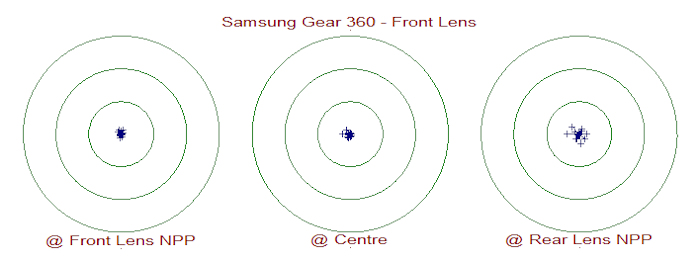
Stitching the images in PTGui from the Front Lens of the Samsung Gear 360 rotated about the NPP of the Front Lens showed an improvement over rotation about the Centre, which was significantly better than rotation about the Rear Lens NPP, as shown above, which is what I would have expected.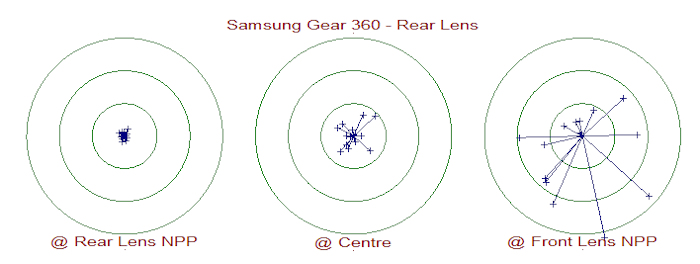
Stitching the images in PTGui from the Rear Lens of the Samsung Gear 360 rotated about the NPP of the Rear Lens also showed an improvement over rotation about the Centre and rotation about the Rear Lens NPP, as shown above, but with a marked difference suggesting that the Front and Rear Lenses are quite different so that if this method is to be used to achieve a good accuracy in the Equirectangular then using the images from the Front Lens rotated about the NPP of the Front Lens is to be preferred.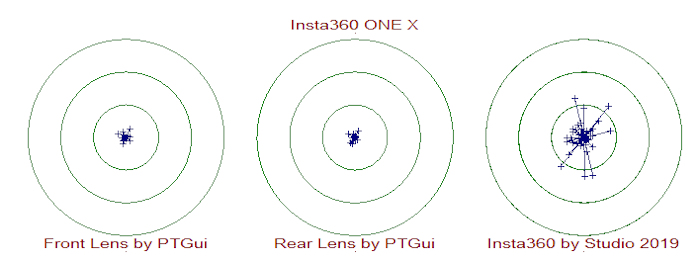
The graphic above shows the results of the images from the Front Lens of the Insta360 ONE X stitched with PTGui on the left, the images from the Rear Lens of the Insta360 ONE X stitched with PTGui in the centre and the combining of both images with Insta360 Studio 2019 on the right, and once again it is clear that 4 shots round stitched with PTGui produces a much more accurate solution.
The Insta360 ONE X was rotated about its centre (tripod bush) and it is possible that rotating about the NPP of the lens may produce a better answer, but the lenses are much closer together than on the Samsung Gear 360 and the results are good without doing this.
The graphic above shows that 4 shots round stitched in PTGui does provide a much more accurate Equirectangular than combining the images using the software provided by the camera manufacturers.
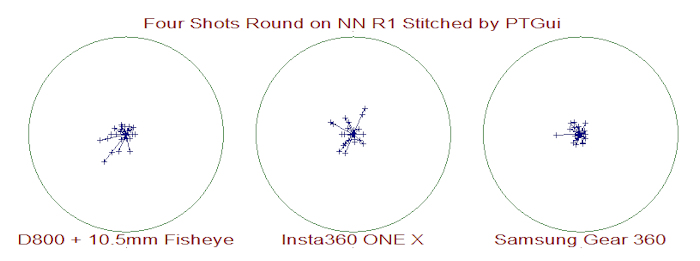
The final graphic shows the angular differences from the “bench mark” angles measured with the Kern DKM2-A 1” Theodolite with the green circle representing 1° of arc.
This investigation suggests that if 360° panoramas are to be used for measurement then it is best to go with rotating the camera about the NPP of the lens rather than use a multi-lens camera, unless such a camera is calibrated for measurement.
This may appear to negate the benefit of using a “single shot” camera, but then such cameras are somewhat lower cost than an FX DSLR and Fisheye lens.
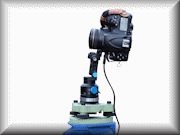 |
Single Lens v Multi-lens Cameras for Accuracy Today there is a plethora of multi-lens cameras for capturing 360° panoramas which have the advantage of a single shot rather than taking a set of shots, but would these have the accuracy required for measurement as there are two fundamental differences between the two methods. Tp make panoramas with a camera with a single lens it is usually mounted on a panohead and rotated about the NPP but with a multi-lens camera this is physically impossible. |
|
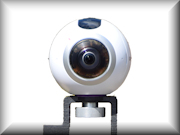 |
Samsung Gear 360 – Further Investigation As Part of the investigation into the accuracy of using a Samsung Gear 360 for measurement, 8shots round at 45° intervals were taken with the camera rotated around its central vertical axis. Each image could be split into the left and right hemispheres providing 4 sets of 4 shots round at 90° providing 50% overlap for Control Point generation in PTGui, two from the front lens and two from the rear lens. Stitching these in PTGui provide a more accurate result than using ActionDirector to join each pair. |
